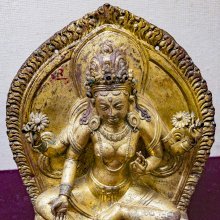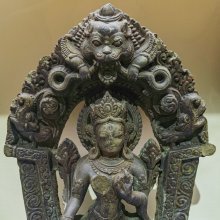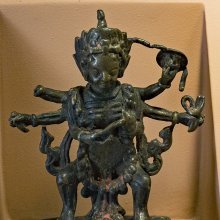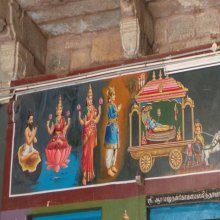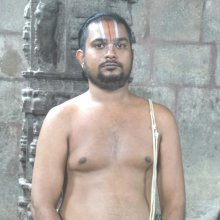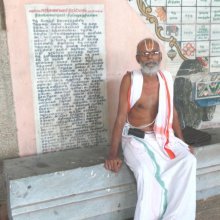Mahalakshmi, Mahālakṣmī, Maha-lakshmi: 28 definitions
Introduction:
Mahalakshmi means something in Buddhism, Pali, Hinduism, Sanskrit, Marathi. If you want to know the exact meaning, history, etymology or English translation of this term then check out the descriptions on this page. Add your comment or reference to a book if you want to contribute to this summary article.
The Sanskrit term Mahālakṣmī can be transliterated into English as Mahalaksmi or Mahalakshmi, using the IAST transliteration scheme (?).
Images (photo gallery)
In Hinduism
Shaivism (Shaiva philosophy)
Source: Wisdom Library: Kubjikāmata-tantraMahālakṣmī (महालक्ष्मी):—Sanskrit name of one of the twenty-four goddesses of the Sūryamaṇḍala (first maṇḍala of the Khecarīcakra) according to the kubjikāmata-tantra. The Khecarīcakra is the fifth cakra (‘internal mystic center’) of the five (pañcacakra) and is located on or above the head. She presides over the pītha (‘sacred site’) called Kolāgiri.
Source: academia.edu: A Critical Study of the Vajraḍākamahātantrarāja (II) (shaivism)Mahālakṣmī (महालक्ष्मी) is the name of a Goddess (Devī) presiding over Kolāgiri: one of the twenty-four sacred districts mentioned in the Kubjikāmatatantra (chapter 22). Her weapon is the daṇḍa. Furthermore, Mahālakṣmī is accompanied by the Kṣetrapāla (field-protector) named Agnika and their abode is an naga-tree. A similar system appears in the 9th century Vajraḍākatantra (chapter 18).
Source: SOAS University of London: Protective Rites in the Netra TantraMahālakṣmī (महालक्ष्मी) refers to “great royal fortune”, according to the Netratantra of Kṣemarāja: a Śaiva text from the 9th century in which Śiva (Bhairava) teaches Pārvatī topics such as metaphysics, cosmology, and soteriology.—Accordingly, [verse 19.114-116, while describing the king’s consecration]—“[...] Then [the Mantrin] should carry out the sacrifice—[which] confers siddhi—within the palace using the method described earlier with abundant oblation, for as long as seven days, O Devi. [The king] then acquires great royal fortune (mahālakṣmī) [and an] unconquerable kingdom, as [he] desires. And the king will obtain the siddhis of the earth and sky. Then, the [Mantrin who performs] the nīrājana achieves [for himself] all the very best things, [and] destroys the aforementioned faults. O Devi, this is certain to take place”.

Shaiva (शैव, śaiva) or Shaivism (śaivism) represents a tradition of Hinduism worshiping Shiva as the supreme being. Closely related to Shaktism, Shaiva literature includes a range of scriptures, including Tantras, while the root of this tradition may be traced back to the ancient Vedas.
Shaktism (Shakta philosophy)
Source: Wisdom Library: Śāktism1) Mahālakṣmī (महालक्ष्मी) refers to the last of the eight Aṣṭamātṛkā (mother Goddesses) of Kathmandu city, locally known as Candralakhu Ajimā. Her location is Nārāyaṇahiṭī.
2) Mahālakṣmī (महालक्ष्मी, “great beauty”):—Name of one of the sixty-four mātṛs to be worshipped during Āvaraṇapūjā (“Worship of the Circuit of Goddesses”, or “Durgā’s Retinue”), according to the Durgāpūjātattva. They should be worshipped with either the five upācāras or perfume and flowers.
Her mantra is as follows:
Source: Google Books: Manthanabhairavatantramॐ महालक्ष्म्यै नमः
oṃ mahālakṣmyai namaḥ.
1) Mahālakṣmī (महालक्ष्मी) (=a form of Kālasaṃkarṣiṇī) is an epithet for the Goddess according to the Bhairavīstotra in the Śrīmatottara-tantra, an expansion of the Kubjikāmatatantra: the earliest popular and most authoritative Tantra of the Kubjikā cult.—Accordingly, “Victory! Victory (to you) O goddess (bhagavatī)! [...] Dweller in cremation grounds! You who delight in the play of dance! Experienced in wonderfully diverse behaviour! Mahālakṣmī! Subtle one! Śivā! Victory to you who have merged the entire universe into a single vibrant state of oneness filling (thereby every) discontinuity! [...]”.
2) Mahālakṣmī (महालक्ष्मी) is the name of a Mātṛkā (‘mother’) and is identified with the sacred site of Devīkoṭa, according to the Manthānabhairavatantra, a vast sprawling work that belongs to a corpus of Tantric texts concerned with the worship of the goddess Kubjikā.—According to the Kubjikā Tantras, the eight major Kaula sacred sites each have a house occupied by a woman of low caste who is identified with a Mother (Mātṛkā).—[...] Ekāmra is identified with (a) the class of sculptress (śilpinī) [or bone crusher woman (asthi-vidāriṇī)], (b) the Mātṛkā or ‘mother’ named Cāmuṇḍā, and (c) with the place of power (śaktisthāna).
3) Mahālakṣmī (महालक्ष्मी) (or Carcikā) is the name of the Goddess associated with the sacred seat of Pūrṇagiri, according to the Manthānabhairavatantra.
4) Mahālakṣmī (महालक्ष्मी) also refers to one of the Siddhas of the Tradition of the Eastern House (pūrvagṛha-āmnāya), according to the Manthānabhairavatantra.
5) Mahālakṣmī (महालक्ष्मी) is associated with letter "Sa" of the Meruprasta (Grid of Meru), according to the Ṭīkā (commentary) on the Manthānabhairavatantra.—Accordingly, [while describing the process to extract Navātman from the grid of Meru]: “Now one should extract (Navātman) again from the grid of Meru. [...] Once extracted ‘the one beginning with (the letter) Ma’, that is Mahālakṣmī, the letter Sa. [...] Thus (we get) SAHAKṢAMALAVARAYA-ŪṂ. Such is the basic form in the entire tradition (and so) the extraction of Navātman is complete. [...]”.
Source: Sreenivasarao's blog: Saptamatrka (part 4)Mahalakshmi refers to one of the seven mother-like goddesses (Matrika).—Mahalakshmi is counted as the eighth Matrika in the Asta-matrika tradition followed in the Nepal region. Mahalakshmi, as Matrka, is not derived from Devi Mahatmya, although she is described as “Universal Mother” in other contexts. As Matrika, Mahalakshmi is regarded as an aspect of Durga; not as Lakshmi the consort of Vishnu. Mahalakshmi here represents her subtle aspect as Mind, specially her Sovereignty. In the Shaktha tradition, Mahalakshmi is an independent Supreme Divinity manifesting herself as Maha-Sarasvathi (Sattva), Mahalakshmi (Rajas) and as Maha-Kali (Tamas).
The Bhavanopanishad (9) recognizes Matrikas as eight types of un-favourable dispositions, such as: desire, anger, greed, delusion, pride, jealousy, demerit and merit. Tantra-raja-tantra (36; 15-16) expands on that and identifies Mahalakshmi with doing good (punya) with other than altruistic reasons.
According to Khadgamala (vamachara) tradition of Sri Vidya, the eight Matrkas are located along the wall (four at the doors and four at the corners) guarding the city (Tripura) on all eight directions: Mahalakshmi on the South-west.

Shakta (शाक्त, śākta) or Shaktism (śāktism) represents a tradition of Hinduism where the Goddess (Devi) is revered and worshipped. Shakta literature includes a range of scriptures, including various Agamas and Tantras, although its roots may be traced back to the Vedas.
Pancaratra (worship of Nārāyaṇa)
Source: Wisdom Library: PāñcarātraMahālakṣmī (महालक्ष्मी, “Great Lakṣmī”):—Another name for Ādilakṣmī, one of the eight primary forms of Lakṣmī (aṣṭhalakṣmī).

Pancaratra (पाञ्चरात्र, pāñcarātra) represents a tradition of Hinduism where Narayana is revered and worshipped. Closeley related to Vaishnavism, the Pancaratra literature includes various Agamas and tantras incorporating many Vaishnava philosophies.
Purana and Itihasa (epic history)
Source: archive.org: Shiva Purana - English TranslationMahālakṣmī (महालक्ष्मी) is the daughter of Janaka and Dhanyā (one of the three daughters of Svadhā), according to the Śivapurāṇa 2.3.2.—Accordingly, as Sanatkumāra said to the three daughters of Svadhā (i.e., Menā, Dhanyā, Kalāvatī) after cursing them:—“[...] O ye three daughters of forefathers (i.e., Dhanyā), listen with pleasure to my words that will dispel your sorrow and bestow happiness on you. [...] The second daughter Dhanyā shall be the Yoginī, the wife of Janaka. Her daughter shall be Mahālakṣmī in the name of Sītā. [...] Janaka shall be blessed by Sītā born in Janaka’s race and he shall be a living liberated soul. A great Yogin, he will attain Vaikuṇṭha. [...] Ye the daughters of forefathers (i.e., Dhanyā) shall shine in heaven. By the vision of Viṣṇu your evil actions have been quelled”.
Source: Cologne Digital Sanskrit Dictionaries: The Purana IndexMahālakṣmī (महालक्ष्मी).—Kāmākṣī;1 mother of Brahmā, Viṣṇu and Īśa;2 is Trīpurāmbikā;3 the goddess enshrined at Karavīra.4
- 1) Brahmāṇḍa-purāṇa IV. 19. 8.
- 2) Ib. IV. 36. 58; 39. 21, 111; 40. 5; Vāyu-purāṇa 109. 23.
- 3) Brahmāṇḍa-purāṇa IV. 41. 3; 44. 111; 43. 85.
- 4) Matsya-purāṇa 13. 41.

The Purana (पुराण, purāṇas) refers to Sanskrit literature preserving ancient India’s vast cultural history, including historical legends, religious ceremonies, various arts and sciences. The eighteen mahapuranas total over 400,000 shlokas (metrical couplets) and date to at least several centuries BCE.
Shilpashastra (iconography)
Source: Sreenivasarao's blog: Saptamatrka (part 4) (shilpa)Mahalakshmi is counted as the eighth Matrika in the Asta-matrika tradition followed in the Nepal region.—Mahalakshmi described as having been created by the effulgence of all the gods is depicted as Ashtadasha Bhuja Mahalakshmi, with eighteen arms.
Skanda Purana (Sahyadri khanda) describes Mahalakshmi as: “She who springs from the body of all gods has a thousand or indeed countless arms, although her image is shown with eighteen hands. Her face is white made from the light streaming from the face of Shiva. Her arms are made of substance of Vishnu are deep blue; her round breasts made of Soma are white. Her waist is Indra and is red. Her feet sprung from Brahma are also red; while her calves’ and thigh sprung from Varuna are blue. She wears a gaily coloured lower garment, brilliant garlands and a veil. In her eighteen arms, starting from the lower left, she holds in her hands: a rosary, a lotus, an arrow, a sword, a hatchet, a club, a discus, an ax, a trident, a conch, a bell, , a noose, a sphere, a stick, a hide, a bow, a chalice and a water pot.”
The Candi-kalpa adds that Mahalakshmi should be seated upon a lotus (saroja-sthitha) and her complexion must be that of coral (pravala-prabha).
The Shilpa text Rupa-mandana suggests Mahalakshmi with four arms (chatur-bhuja) should be depicted in the colour of molten-gold and decorated with golden ornaments (kancana-bhushana). She is also described as having complexion of coral; and seated on a lotus. Her four hands carry matulunga fruit, mace, shield and bowl of liquor. Her head must be adorned with snake-hood and a linga.
Source: Shodhganga: The significance of the mūla-beras (śilpa)Mahālakṣmī (महालक्ष्मी) is the name of a deity depicted in various temples:
The Jambukeswarar Temple in Tiruvānaikoyil (Thiruvanaikaval), [Śiva temple].—Mahālakṣmī is found in standing posture with four hands. The upper two hands hold the lotus in kaṭaka-hasta. The lower right hand is in abhaya and the lower left hand is in varada.
The Adi Kumbeswarar Temple (Ādi Kumbheśvara), [another Śiva temple].—Mahālakṣmī is found in ardhapadmāsana posture with four hands. The upper hands are in kaṭaka-hasta and the lower right and left hands in abhaya and varada-hasta respectively.
Mahālakṣmī as part of the Aṣṭaśakti, or “eight powers” is depicted in the Meenakshi Temple in Madurai (or Madura), [Devī or Goddess temple].—The entrance on the eastern side of the temple leads to the Aṣṭaśakti-maṇḍapa. On the left there are four śakti (powers) [viz., Mahālakṣmī].
The Subramanya Swamy Temple (or Subramaṇya Svāmi Temple) in Thiruparankundram or Parankundram (Paraṅkuṉṟam), [Murugan temple].—Mahālakṣmī is seen behind the image of Vināyaka. She is represented as seated with one pair of hands. The sitting posture is ardha-padmāsana. In iconographic description, Mahālakṣmī is seated in padmāsana posture. In the Kampatati Maṇḍapa, there are steps that lead straight to the main sanctum. On either side of the steps are the images of Andarabharanar Svāmi, also known as Bhūta Sumathi Pati, and Śrī Anukkai Vināyaka to the left of the devotee and Ugramūrti Svāmi to the right of the devotee.

Shilpashastra (शिल्पशास्त्र, śilpaśāstra) represents the ancient Indian science (shastra) of creative arts (shilpa) such as sculpture, iconography and painting. Closely related to Vastushastra (architecture), they often share the same literature.
Chandas (prosody, study of Sanskrit metres)
Source: Shodhganga: a concise history of Sanskrit Chanda literatureMahālakṣmī (महालक्ष्मी) refers to one of the 130 varṇavṛttas (syllabo-quantitative verse) dealt with in the second chapter of the Vṛttamuktāvalī, ascribed to Durgādatta (19th century), author of eight Sanskrit work and patronised by Hindupati: an ancient king of the Bundela tribe (presently Bundelkhand of Uttar Pradesh). A Varṇavṛtta (e.g., mahā-lakṣmī) refers to a type of classical Sanskrit metre depending on syllable count where the light-heavy patterns are fixed.

Chandas (छन्दस्) refers to Sanskrit prosody and represents one of the six Vedangas (auxiliary disciplines belonging to the study of the Vedas). The science of prosody (chandas-shastra) focusses on the study of the poetic meters such as the commonly known twenty-six metres mentioned by Pingalas.
Kavya (poetry)
Source: Wisdom Library: KathāsaritsāgaraMahālakṣmī (महालक्ष्मी) is one of the epithets of Durgā, according to the Kathāsaritsāgara, chapter 53. Accordingly, as Vīravara praised Durgā: “... thou art the principle of life in creatures; by thee this world moves. In the beginning of creation Śiva beheld thee self-produced, blazing and illuminating the world with brightness hard to behold, like ten million orbs of fiery suddenly produced infant suns rising at once, filling the whole horizon with the circle of thy arms, bearing a sword, a club, a bow, arrows and a spear. And thou wast praised by that god Śiva in the following words ... [Mahālakṣmī, etc...]”.
Also, “... when Skanda, and Vasiṣṭha, and Brahmā, and the others heard thee praised, under these [eg., Mahālakṣmī] and other titles, by Śiva well skilled in praising, they also praised thee. And by praising thee, O adorable one, immortals, Ṛṣis and men obtained, and do now obtain, boons above their desire. ”
The Kathāsaritsāgara (‘ocean of streams of story’), mentioning Mahālakṣmī, is a famous Sanskrit epic story revolving around prince Naravāhanadatta and his quest to become the emperor of the vidyādharas (celestial beings). The work is said to have been an adaptation of Guṇāḍhya’s Bṛhatkathā consisting of 100,000 verses, which in turn is part of a larger work containing 700,000 verses.

Kavya (काव्य, kavya) refers to Sanskrit poetry, a popular ancient Indian tradition of literature. There have been many Sanskrit poets over the ages, hailing from ancient India and beyond. This topic includes mahakavya, or ‘epic poetry’ and natya, or ‘dramatic poetry’.
Vaishnavism (Vaishava dharma)
Source: Pure Bhakti: Brhad BhagavatamrtamMahālakṣmī (महालक्ष्मी) refers to:—(see Lakṣmī). (cf. Glossary page from Śrī Bṛhad-bhāgavatāmṛta).

Vaishnava (वैष्णव, vaiṣṇava) or vaishnavism (vaiṣṇavism) represents a tradition of Hinduism worshipping Vishnu as the supreme Lord. Similar to the Shaktism and Shaivism traditions, Vaishnavism also developed as an individual movement, famous for its exposition of the dashavatara (‘ten avatars of Vishnu’).
In Buddhism
Tibetan Buddhism (Vajrayana or tantric Buddhism)
Source: academia.edu: A Critical Study of the Vajraḍākamahātantrarāja (II)Mahālakṣmī (महालक्ष्मी) or Jvālāmukhī is the name of a Goddess (Devī) presiding over Kollagiri: one of the twenty-four sacred districts mentioned in the 9th century Vajraḍākatantra (chapter 18). Her weapon is the khaḍga. Furthermore, Mahālakṣmī is accompanied by the Kṣetrapāla (field-protector) named Agnimukha [or Mahāvrata] and their abode is the top of the mountain [or the nimba-tree]
Source: academia.edu: The Structure and Meanings of the Heruka MaṇḍalaMahālakṣmī (महालक्ष्मी) refers to the Ḍākinī of the north-eastern corner in the Medinīcakra, according to the 10th century Ḍākārṇava chapter 15. Accordingly, the medinīcakra refers to one of the three divisions of the dharma-puṭa (‘dharma layer’), situated in the Herukamaṇḍala. Two colors are evenly assigned to the four corner Ḍākinīs [viz., Mahālakṣmī] in order in accordance with the direction which they face.
Source: academia.edu: Holy Sites in Buddhist Saṃvara CycleMahālakṣmī (महालक्ष्मी) refers to one of the eight inner channels running through the dharmacakra, according to the 10th century Ḍākārṇava. Dharmacakra is an inner circle of the shape of a lotus with eight petals. This inner circle is visualized at one’s heart region. The inner channels [viz., Mahālakṣmī] run through the petals of these inner circles.
Source: OSU Press: Cakrasamvara SamadhiMahālakṣmī (महालक्ष्मी) refers to “great wealth”, according to the purification (śodhana) of the Pañcagavya (five cow products) ritual often performed in combination with the Cakrasaṃvara Samādhi, which refers to the primary pūjā and sādhanā practice of Newah Mahāyāna-Vajrayāna Buddhists in Nepal.—Accordingly, “Compassionate Nandā, Bhadrā, Jayā, Saumyā and Kapilā, Accomplish great wealth (mahālakṣmī), long life, health and success”.

Tibetan Buddhism includes schools such as Nyingma, Kadampa, Kagyu and Gelug. Their primary canon of literature is divided in two broad categories: The Kangyur, which consists of Buddha’s words, and the Tengyur, which includes commentaries from various sources. Esotericism and tantra techniques (vajrayāna) are collected indepently.
Languages of India and abroad
Marathi-English dictionary
Source: DDSA: The Molesworth Marathi and English Dictionarymahālakṣmī (महालक्ष्मी).—f (S) Saraswati, the wife of Brahma. 2 The festival in honor of her on the eighth of āśvina.
Source: DDSA: The Aryabhusan school dictionary, Marathi-Englishmahālakṣmī (महालक्ष्मी).—f The goddess Lakshmi.
Marathi is an Indo-European language having over 70 million native speakers people in (predominantly) Maharashtra India. Marathi, like many other Indo-Aryan languages, evolved from early forms of Prakrit, which itself is a subset of Sanskrit, one of the most ancient languages of the world.
Sanskrit dictionary
Source: DDSA: The practical Sanskrit-English dictionaryMahālakṣmī (महालक्ष्मी).—
1) the great Lakṣmī, or Śakti of Nārāyaṇa; सेवे सैरिभमर्दिनीमिह महालक्ष्मीं सरोजस्थिताम् (seve sairibhamardinīmiha mahālakṣmīṃ sarojasthitām).
2) a young girl who represents the goddess Durgā at the Durgā festival.
Mahālakṣmī is a Sanskrit compound consisting of the terms mahā and lakṣmī (लक्ष्मी).
Source: Cologne Digital Sanskrit Dictionaries: Shabda-Sagara Sanskrit-English DictionaryMahālakṣmī (महालक्ष्मी).—f.
(-kṣmīḥ) 1. Saraswati the wife of Brahma. 2. A young girl who personates Durga at the festival of that goddess. E. mahā great, and lakṣmī the goddess Lakshmi.
Source: Cologne Digital Sanskrit Dictionaries: Benfey Sanskrit-English DictionaryMahālakṣmī (महालक्ष्मी).—f. Sarasvatī. Rājalakṣmī, i. e.
Mahālakṣmī is a Sanskrit compound consisting of the terms mahā and lakṣmī (लक्ष्मी).
Source: Cologne Digital Sanskrit Dictionaries: Monier-Williams Sanskrit-English Dictionary1) Mahālakṣmī (महालक्ष्मी):—[=mahā-lakṣmī] [from mahā > mah] f. the gr° Lakṣmī (properly the Śakti of Nārāyaṇa or Viṣṇu, but sometimes identified with Durgā or with Sarasvatī; also Name of Dākṣāyaṇī in Kara-vīra), [Pañcarātra; Kathāsaritsāgara] (cf. [Religious Thought and Life in India 385])
2) [v.s. ...] Name of a girl 13 years old and not arrived at puberty (who represents the goddess Durgā at the D° festival), [cf. Lexicographers, esp. such as amarasiṃha, halāyudha, hemacandra, etc.]
3) [v.s. ...] of a woman, [Catalogue(s)]
4) [v.s. ...] a kind of metre, [Colebrooke]
Source: Cologne Digital Sanskrit Dictionaries: Yates Sanskrit-English DictionaryMahālakṣmī (महालक्ष्मी):—[mahā+lakṣmī] (kṣmī) 3. f. Saraswatī.
[Sanskrit to German]
Sanskrit, also spelled संस्कृतम् (saṃskṛtam), is an ancient language of India commonly seen as the grandmother of the Indo-European language family (even English!). Closely allied with Prakrit and Pali, Sanskrit is more exhaustive in both grammar and terms and has the most extensive collection of literature in the world, greatly surpassing its sister-languages Greek and Latin.
Kannada-English dictionary
Source: Alar: Kannada-English corpusMahālakṣmi (ಮಹಾಲಕ್ಷ್ಮಿ):—
1) [noun] Lakṣmi, the Goddess of Wealth, and consort of Viṣṇu.
2) [noun] Sarasvati, the Goddess of Learning.
3) [noun] Durge, consort of Śiva.
Kannada is a Dravidian language (as opposed to the Indo-European language family) mainly spoken in the southwestern region of India.
See also (Relevant definitions)
Partial matches: Lakshmi, Maha.
Starts with: Mahalakshmibahyapujanapaddhati, Mahalakshmihridaya, Mahalakshmihridayastotra, Mahalakshmikalpa, Mahalakshminamavidhi, Mahalakshmipaddhati, Mahalakshmipuja, Mahalakshmipura, Mahalakshmiratnakosha, Mahalakshmisahasranaman, Mahalakshmisahasranamastotra, Mahalakshmistotra, Mahalakshmisukta, Mahalakshmitirtha, Mahalakshmivilasa, Mahalakshmivrata, Mahalakshmivratakatha, Mahalakshmivratapuja, Mahalakshmivratodyapanavidhi.
Full-text (+173): Mahalakshmikalpa, Mahalakshmisukta, Mahalakshmipaddhati, Mahalakshmistotra, Mahalakshmihridaya, Mahalakshmivratapuja, Mahalakshmihridayastotra, Mahalakshminamavidhi, Mahalakshmiratnakosha, Mahalakshmivrata, Mahalakshmitirtha, Mahalakshmivilasa, Mahalakkumi, Makalatcumi, Kolhapura, Mahalakshmyashtaka, Ashtamatrika, Bodana, Sita, Kolagiri.
Relevant text
Search found 43 books and stories containing Mahalakshmi, Mahālakṣmī, Maha-lakshmi, Maha-laksmi, Mahalaksmi, Mahā-lakṣmī, Mahālakṣmi; (plurals include: Mahalakshmis, Mahālakṣmīs, lakshmis, laksmis, Mahalaksmis, lakṣmīs, Mahālakṣmis). You can also click to the full overview containing English textual excerpts. Below are direct links for the most relevant articles:
Puranic encyclopaedia (by Vettam Mani)
Chaitanya Bhagavata (by Bhumipati Dāsa)
Verse 2.18.163 < [Chapter 18 - Mahāprabhu’s Dancing as a Gopī]
Verse 2.18.127 < [Chapter 18 - Mahāprabhu’s Dancing as a Gopī]
Verse 1.14.99 < [Chapter 14 - The Lord’s Travel to East Bengal and the Disappearance of Lakṣmīpriyā]
Tiruvaymoli (Thiruvaimozhi): English translation (by S. Satyamurthi Ayyangar)
Pasuram 10.4.10 < [Section 4 - Fourth Tiruvaymoli (Carve tavanori)]
Pasuram 10.10.6 < [Section 10 - Tenth Tiruvaymoli (Muniye! nanmukane!)]
Pasuram 1.6.9 < [Section 6 - Sixth Tiruvaymoli (Parivatu il icanai)]
Bhagavad-gita-mahatmya (by Shankaracharya)
Brihad Bhagavatamrita (commentary) (by Śrī Śrīmad Bhaktivedānta Nārāyana Gosvāmī Mahārāja)
Verse 2.4.169 < [Chapter 4 - Vaikuṇṭha (the spiritual world)]
Verse 2.4.168 < [Chapter 4 - Vaikuṇṭha (the spiritual world)]
Verse 2.4.91 < [Chapter 4 - Vaikuṇṭha (the spiritual world)]
The Devi Bhagavata Purana (by Swami Vijñanananda)
Related products
